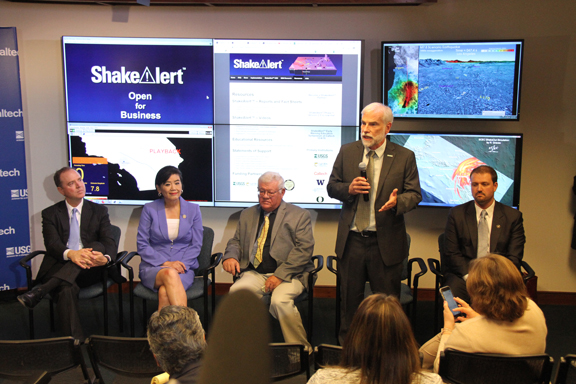
From left, Rep. Adam Schiff, Rep. Judy Chu, Tom Heaton (Caltech), Doug Given (USGS) and Ryan Arba (CA Office of Emergency Services).
By Charly SHELTON
After years of on-again, off-again budget appropriations, media campaigns, touting of importance and presentation of the science, the earthquake early warning system ShakeAlert is finally live. The project has been in development since 2006 and has been through three Administrations of budget cuts and eventual partial funding, getting closer to going live. Now it is open for business and ready to be implemented with buildings and services around the state.
ShakeAlert is an early warning system designed to register earthquakes at the moment the shaking begins, then pass along notifications to receptor systems up and down the coast from California to Washington. These receptor systems are specific to whichever service they will be developed for, be it for slowing Metro trains or automatically shutting off gas lines in large buildings or even giving surgeons a few seconds of warning during surgery to remove themselves and protect the patient as best as they can.
“When [colleagues and the public] asked how long would it take to do [develop the system], I told them if we decided to do it we could do it in five years. That was 40 years ago,” said Tom Heaton, professor of Engineering Seismology at Caltech, who wrote the initial concept paper back in 1985. “And what it really takes is leadership to do that. I’m a geek; my strength is working on science. We really needed a political leadership from our congressman. Adam Schiff has been a tireless leader.”
Heaton also lauded Ken Calvert, the congressman from Riverside, who worked with Congressman Schiff on the project.
“It’s just so reassuring in this time of seeming acrimony in Washington, D.C., to see our congresspeople get together for the good of California,” Heaton added.
Congressman Schiff has worked to get funding for this project almost since day one after being elected to office. After years of gathering support from both sides of the aisle, he can finally see the project ready to launch.
“It’s very gratifying. There are a couple of things that I’ve worked on over the years that I’ve gotten to see quite tangibly reach fruition, and actually they’re overlapping here. One was the Gold Line, which was, at the time I got involved as a state legislator, a project that was being killed. We established a joint powers agency to get that done and it was, and it’s now being expanded,” Schiff said. “Similarly, this has gone from concept to fruition on my watch, which is very exciting, and ultimately these systems will work with each other where, when the Gold Line and the other aspects of Metro are running, they’ll be able to get automatic information and slow those trains and protect the public.”
The project going live was announced last week in a press conference at Caltech where leading seismologists and geologists explained where the system is now in development and what is coming. ShakeAlert as an alert system is live and working, but it needs a destination to send the alerts. It needs other engineers to develop the specific software to take the alert and automate the safety procedures for each specific building or service. And even more important than the safety during a quake is the feeling of control members of the public will get knowing what’s coming.
“I have become focused on resilience – how do we really pull through the earthquake? Because we are emotionally very afraid of dying in the earthquake, but when you look at what it does, it’s whether or not our society survives this. It’s not dying in the earthquake, it’s living after the earthquake that’s such a challenge,” said Dr. Lucy Jones, research associate in geophysics at Caltech. “
She reiterated that with ShakeAlert comes a feeling of control when a person is able to know that an aftershock is coming and it’s going to stay small.
“We won’t see the aftershock sequences driving people out of the city, which we saw in 1994 [and] we saw in 1971. The only years Los Angeles has ever lost population were the years after our really big earthquakes,” she said. “The psychology of knowing ‘this one’s going to be small’ is going to help people cope with it in a way that goes beyond any of the physical losses, and that’s as important as anything else.”
